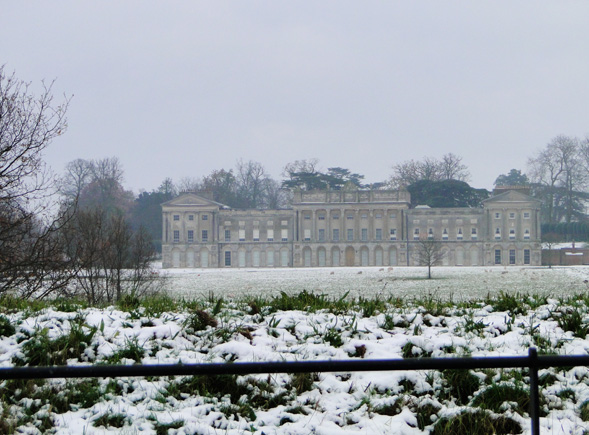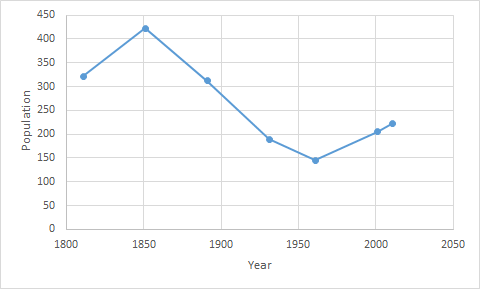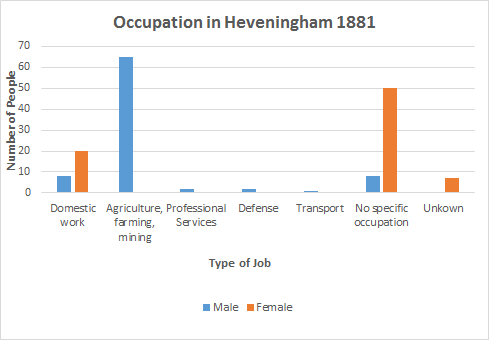Heveningham on:
[Wikipedia]
[Google]
[Amazon]
Heveningham is a village and
 In 1870–1872, John Marius Wilson's ''Imperial Gazetteer of England and Wales'' described the parish as: ”Haveningham, or Heveningham, a village and parish in Blything district, Suffolk.”
In 1870–1872, John Marius Wilson's ''Imperial Gazetteer of England and Wales'' described the parish as: ”Haveningham, or Heveningham, a village and parish in Blything district, Suffolk.”

 Around the year 1800 the population of the parish was higher than it is now, at approximately 310 people. There was a sharp decrease in the hundred years between 1850 and 1950, when the population fell from approximately 425 to 150. The decrease in population in the 19th century could be due to emigration towards urban centres due to the
Around the year 1800 the population of the parish was higher than it is now, at approximately 310 people. There was a sharp decrease in the hundred years between 1850 and 1950, when the population fell from approximately 425 to 150. The decrease in population in the 19th century could be due to emigration towards urban centres due to the


 At the 2011 census, 58 women claimed to be in employment. Three were employed in the Fishing, Agriculture, and Forestry sector, and thirteen said they worked in Human Health and Social Work Activities. In contrast, 61 males claimed to be in employment in 2011. Seven worked in the Agriculture, Fishing, and forestry sector, while seven worked in construction, and six in the Professional/Scientific sector.
At the 2011 census, 58 women claimed to be in employment. Three were employed in the Fishing, Agriculture, and Forestry sector, and thirteen said they worked in Human Health and Social Work Activities. In contrast, 61 males claimed to be in employment in 2011. Seven worked in the Agriculture, Fishing, and forestry sector, while seven worked in construction, and six in the Professional/Scientific sector.
civil parish
In England, a civil parish is a type of administrative parish used for local government. It is a territorial designation which is the lowest tier of local government below districts and counties, or their combined form, the unitary authorit ...
in the East Suffolk district of Suffolk in eastern England
England is a country that is part of the United Kingdom. It shares land borders with Wales to its west and Scotland to its north. The Irish Sea lies northwest and the Celtic Sea to the southwest. It is separated from continental Europe b ...
. Located four miles south-west of Halesworth
Halesworth is a market town, civil parish and electoral ward in north-eastern Suffolk, England. The population stood at 4,726 in the 2011 Census. It lies south-west of Lowestoft, on a tributary of the River Blyth, upstream from Southwold. T ...
, in 2005 it had a population of 120.
Heveningham Hall
Heveningham Hall is a Grade I listed building in Heveningham, Suffolk. The first house on the site was built for the politician and regicide William Heveningham in 1658. The present house, dating from 1778 to 1780, was designed by Sir Robert ...
, a country house built in 1777, once belonged to the Lords Huntingfield.
History
Historic buildings
Church of St Margaret
St. Margaret's Church, built in 1539, is a Perpendicular style parish church and is now a Grade Ilisted building
In the United Kingdom, a listed building or listed structure is one that has been placed on one of the four statutory lists maintained by Historic England in England, Historic Environment Scotland in Scotland, in Wales, and the Northern Irel ...
.
Heveningham Hall

Heveningham Hall
Heveningham Hall is a Grade I listed building in Heveningham, Suffolk. The first house on the site was built for the politician and regicide William Heveningham in 1658. The present house, dating from 1778 to 1780, was designed by Sir Robert ...
is a Grade I
In the United Kingdom, a listed building or listed structure is one that has been placed on one of the four statutory lists maintained by Historic England in England, Historic Environment Scotland in Scotland, in Wales, and the Northern Irel ...
listed building that stands on the site of an earlier house built for William Heveningham in 1658.
Country fair
The summer fair is held annually in the grounds ofHeveningham Hall
Heveningham Hall is a Grade I listed building in Heveningham, Suffolk. The first house on the site was built for the politician and regicide William Heveningham in 1658. The present house, dating from 1778 to 1780, was designed by Sir Robert ...
and is a landmark event for the Parish, as it highlights the local rural traditions. Activities include a Sheep Show, Clay Pigeon Shooting, and a Poultry Exhibition.
Population
 Around the year 1800 the population of the parish was higher than it is now, at approximately 310 people. There was a sharp decrease in the hundred years between 1850 and 1950, when the population fell from approximately 425 to 150. The decrease in population in the 19th century could be due to emigration towards urban centres due to the
Around the year 1800 the population of the parish was higher than it is now, at approximately 310 people. There was a sharp decrease in the hundred years between 1850 and 1950, when the population fell from approximately 425 to 150. The decrease in population in the 19th century could be due to emigration towards urban centres due to the Industrial Revolution
The Industrial Revolution was the transition to new manufacturing processes in Great Britain, continental Europe, and the United States, that occurred during the period from around 1760 to about 1820–1840. This transition included going f ...
and undoubtedly due to both the First World War
World War I (28 July 1914 11 November 1918), often abbreviated as WWI, was one of the deadliest global conflicts in history. Belligerents included much of Europe, the Russian Empire, the United States, and the Ottoman Empire, with fightin ...
and Second World War
World War II or the Second World War, often abbreviated as WWII or WW2, was a world war that lasted from 1939 to 1945. It involved the vast majority of the world's countries—including all of the great powers—forming two opposi ...
. Since 1960, there has been a gradual increase in population, and in 2011, including Ubbeston 225 people occupied the area.
Demographics
Age profile
In 2011 there were 52 people under the age of twenty-one, and approximately fifty people between the ages of 61 and 100, this created a large proportion of the population who were dependent on the working population. There were around 123 people between the ages of 20-61 considered economically active.Ethnicity
According to the census, in 2011 Heveningham had a population of 223 people, of whom 218 described themselves as of White English/Welsh/Northern Irish/British origin, which is 97% of the total population. Of the remaining five people, four described themselves as White from outside the United Kingdom, and one claimed to be of Mixed/Multiple Ethnicity; White/Black Caribbean.
Occupations
The 1881 census shows that agriculture, including cattle rearing, was the main occupation in Heveningham. The area was once devoted to pasture, with over sixty men working in the sector. Men dominated the working population, with fifty women at the time stating they had no specific occupation. The number of people working in the domestic sector was high (especially for women) in 1881, partly due toHeveningham Hall
Heveningham Hall is a Grade I listed building in Heveningham, Suffolk. The first house on the site was built for the politician and regicide William Heveningham in 1658. The present house, dating from 1778 to 1780, was designed by Sir Robert ...
, where many servants were employed.

 At the 2011 census, 58 women claimed to be in employment. Three were employed in the Fishing, Agriculture, and Forestry sector, and thirteen said they worked in Human Health and Social Work Activities. In contrast, 61 males claimed to be in employment in 2011. Seven worked in the Agriculture, Fishing, and forestry sector, while seven worked in construction, and six in the Professional/Scientific sector.
At the 2011 census, 58 women claimed to be in employment. Three were employed in the Fishing, Agriculture, and Forestry sector, and thirteen said they worked in Human Health and Social Work Activities. In contrast, 61 males claimed to be in employment in 2011. Seven worked in the Agriculture, Fishing, and forestry sector, while seven worked in construction, and six in the Professional/Scientific sector.
Notable people
* Sir Edward Echyngham (died 1527) owned the manor of Blaunchards in Heveningham * Joshua Vanneck, 1st Baron Huntingfield (1745–1816) * Joshua Vanneck, 1st Baron Huntingfield (1778–1844) *Bruce Reynolds, later the brains behind the Great Train Robbery of 1963, was evacuated to Heveningham during theSecond World War
World War II or the Second World War, often abbreviated as WWII or WW2, was a world war that lasted from 1939 to 1945. It involved the vast majority of the world's countries—including all of the great powers—forming two opposi ...
.
*Air Vice Marshal Thomas Traill (1899–1973) and the actor Stratford Johns
Alan Edgar Stratford Johns (22 September 1925 – 29 January 2002), known as Stratford Johns, was a British stage, film and television actor who is best remembered for his starring role as Detective Inspector Charlie Barlow in the long-running ...
ended their lives in the village.
References
{{authority control Villages in Suffolk Civil parishes in Suffolk